Effects of Composite Warm Mix Additive (CAR) on the Physical and Rheological Performance of Bitumen and the Pavement Performance of Its Concrete
Abstract
:1. Introduction
2. Materials and Experimental Methods
2.1. Materials
2.1.1. Bituminous Binder
2.1.2. Aggregates and Mineral Filler
2.1.3. Preparation of Composite Additive Modified Bitumen (CAMB)
2.2. Experimental Methods
2.2.1. Mix Design of Bituminous Mixture
2.2.2. Physical Performance Tests of Bitumen
2.2.3. Bending-Beam Rheometer (BBR) Test
2.2.4. Brookfield Viscosity Test
2.2.5. Wheel Tracking Test
2.2.6. Three-Point Bending (3PB) Test
2.2.7. Indirect Tensile Test (ITT) and Moisture Sensitivity Test
3. Results and Discussion
3.1. Physical Properties of CAMB
3.2. Rheological Performance of CAMB
3.2.1. Creep Stiffness of CAMB
3.2.2. Viscosity of CAMB
3.3. Pavement Performance of CAMB Concrete
3.3.1. Anti-Rutting Property of CAMB Concrete
3.3.2. Low-Temperature Crack Resistance of CAMB Concrete
3.3.3. Moisture Sensitivity of CAMB Concrete
4. Conclusions
Author Contributions
Funding
Acknowledgments
Conflicts of Interest
References
- Zhang, J.; Apeagyei, A.K.; Airey, G.D.; Grenfell, J.R. Influence of aggregate mineralogical composition on water resistance of aggregate–bitumen adhesion. Int. J. Adhes. Adhes. 2015, 62, 45–54. [Google Scholar] [CrossRef]
- Stotko, O. Energy and Related Carbon Emission Reduction Technologies for Hot Mix Asphalt Plants. In Proceedings of the 10th conference on asphalt pavements for Southern Africa—CAPSA, Winterton, South Africa, 11–14 September 2011. [Google Scholar]
- Almeida-Costa, A.; Benta, A. Economic and environmental impact study of warm mix asphalt compared to hot mix asphalt. J. Clean. Prod. 2016, 112, 2308–2317. [Google Scholar] [CrossRef]
- Moretti, L.; Mandrone, V.; D’Andrea, A.; Caro, S. Comparative “from cradle to gate” life cycle assessments of Hot Mix Asphalt (HMA) materials. Sustainability 2017, 9, 400. [Google Scholar] [CrossRef]
- Xuan, D.; Molenaar, A.A.; Houben, L.J. Compressive and indirect tensile strengths of cement-treated mix granulates with recycled masonry and concrete aggregates. J. Mater. Civ. Eng. 2011, 24, 577–585. [Google Scholar] [CrossRef]
- Cui, P.; Wu, S.; Xiao, Y.; Wan, M.; Cui, P. Inhibiting effect of Layered Double Hydroxides on the emissions of volatile organic compounds from bituminous materials. J. Clean. Prod. 2015, 108, 987–991. [Google Scholar] [CrossRef]
- Pan, P.; Wu, S.; Xiao, Y.; Liu, G. A review on hydronic asphalt pavement for energy harvesting and snow melting. Renew. Sustain. Energy Rev. 2015, 48, 624–634. [Google Scholar] [CrossRef]
- Krol, J.B.; Kowalski, K.J.; Radziszewski, P.; Sarnowski, M. Rheological behaviour of n-alkane modified bitumen in aspect of Warm Mix Asphalt technology. Constr. Build. Mater. 2015, 93, 703–710. [Google Scholar] [CrossRef]
- Silva, H.M.; Oliveira, J.R.; Peralta, J.; Zoorob, S.E. Optimization of warm mix asphalts using different blends of binders and synthetic paraffin wax contents. Constr. Build. Mater. 2010, 24, 1621–1631. [Google Scholar] [CrossRef]
- Ranieri, V.; Kowalski, K.J.; Berloco, N.; Colonna, P.; Perrone, P. Influence of wax additives on the properties of porous asphalts. Constr. Build. Mater. 2017, 145, 261–271. [Google Scholar] [CrossRef]
- Mo, L.; Li, X.; Fang, X.; Huurman, M.; Wu, S. Laboratory investigation of compaction characteristics and performance of warm mix asphalt containing chemical additives. Constr. Build. Mater. 2012, 37, 239–247. [Google Scholar] [CrossRef]
- Rubio, M.C.; Martínez, G.; Baena, L.; Moreno, F. Warm mix asphalt: An overview. J. Clean. Prod. 2012, 24, 76–84. [Google Scholar] [CrossRef]
- Abdullah, M.E.; Zamhari, K.A.; Buhari, R.; Khatijah, S.; Bakar, A.; Hidayah, N.; Hassan, S. Warm mix asphalt technology: A review. J. Teknol. 2014, 3, 39–52. [Google Scholar] [CrossRef]
- Aragão, F.T.S.; Lee, J.; Kim, Y.-R.; Karki, P. Material-specific effects of hydrated lime on the properties and performance behavior of asphalt mixtures and asphaltic pavements. Constr. Build. Mater. 2010, 24, 538–544. [Google Scholar] [CrossRef]
- Kheradmand, B.; Muniandy, R.; Hua, L.T.; Yunus, R.B.; Solouki, A. An overview of the emerging warm mix asphalt technology. Int. J. Pavement Eng. 2014, 15, 79–94. [Google Scholar] [CrossRef]
- Roja, K.L.; Padmarekha, A.; Krishnan, J.M. Rheological investigations on warm mix asphalt binders at high and intermediate temperature ranges. J. Mater. Civ. Eng. 2018, 30, 04018038. [Google Scholar] [CrossRef]
- Hailesilassie, B.W.; Hugener, M.; Bieder, A.; Partl, M.N. New experimental methods for characterizing formation and decay of foam bitumen. Mater. Struct. 2016, 49, 2439–2454. [Google Scholar] [CrossRef]
- Capitão, S.; Picado-Santos, L.; Martinho, F. Pavement engineering materials: Review on the use of warm-mix asphalt. Constr. Build. Mater. 2012, 36, 1016–1024. [Google Scholar] [CrossRef]
- Banerjee, A.; de Fortier Smit, A.; Prozzi, J.A. The effect of long-term aging on the rheology of warm mix asphalt binders. Fuel 2012, 97, 603–611. [Google Scholar] [CrossRef]
- Silva, H.M.R.D.D.; Oliveira, J.; Ferreira, C.; Peralta, E.J.F. Evaluation of the Rheological Behaviour of Warm Mix Asphalt (WMA) Modified Binders. In International RILEM Symposium on Advanced Testing and Characterization of Bituminous Materials (ATCBM09), 7th ed.; Taylor & Francis: New York, NY, USA, 2009; pp. 661–673. [Google Scholar]
- Xiao, F.; Punith, V.; Amirkhanian, S.N. Effects of non-foaming WMA additives on asphalt binders at high performance temperatures. Fuel 2012, 94, 144–155. [Google Scholar] [CrossRef]
- Hanz, A.J.; Faheem, A.; Mahmoud, E.; Bahia, H.U. Measuring effects of warm-mix additives: Use of newly developed asphalt binder lubricity test for the dynamic shear rheometer. Transp. Res. Rec. 2010, 2180, 85–92. [Google Scholar] [CrossRef]
- Bennert, T.; Reinke, G.; Mogawer, W.; Mooney, K. Assessment of workability and compactability of warm-mix asphalt. Transp. Res. Rec. 2010, 2180, 36–47. [Google Scholar] [CrossRef]
- Ferrotti, G.; Ragni, D.; Lu, X.; Canestrari, F. Effect of warm mix asphalt chemical additives on the mechanical performance of asphalt binders. Mater. Struct. 2017, 50, 226. [Google Scholar] [CrossRef]
- Leng, Z.; Gamez, A.; Al-Qadi, I.L. Mechanical property characterization of warm-mix asphalt prepared with chemical additives. J. Mater. Civ. Eng. 2013, 26, 304–311. [Google Scholar] [CrossRef]
- Hamzah, M.O.; Golchin, B.; Jamshidi, A.; Chailleux, E. Evaluation of Rediset for use in warm-mix asphalt: A review of the literatures. Int. J. Pavement Eng. 2015, 16, 809–831. [Google Scholar] [CrossRef]
- Bennert, T.; Maher, A.; Sauber, R. Influence of production temperature and aggregate moisture content on the initial performance of warm-mix asphalt. Transp. Res. Rec. 2011, 2208, 97–107. [Google Scholar] [CrossRef]
- Elseifi, M.A.; Mohammad, L.N.; Kassem, E.; Ying, H.; Masad, E. Quantification of damage in the dynamic complex modulus and flow number tests using X-ray computed tomography. J. Mater. Civ. Eng. 2011, 23, 1687–1696. [Google Scholar] [CrossRef]
- Sampath, A. Comprehensive Evaluation of Four Warm Asphalt Mixture Regarding Viscosity, Tensile Strength, Moisture Sensitivity, Dynamic Modulus and Flow Number. Master’s Thesis, University of Iowa, Iowa City, IA, USA, 2010. [Google Scholar]
- Zhang, J.; Airey, G.D.; Grenfell, J.; Yao, Z. Laboratory evaluation of Rediset modified bitumen based on rheology and adhesion properties. Constr. Build. Mater. 2017, 152, 683–692. [Google Scholar] [CrossRef]
- Zhang, J.; Yao, Z.; Yu, T.; Liu, S.; Jiang, H. Experimental evaluation of crumb rubber and polyethylene integrated modified asphalt mixture upon related properties. Road Mater. Pavement Des. 2019, 20, 1413–1428. [Google Scholar] [CrossRef]
- Yao, Z.; Zhang, J.; Gao, F.; Liu, S.; Yu, T. Integrated utilization of recycled crumb rubber and polyethylene for enhancing the performance of modified bitumen. Constr. Build. Mater. 2018, 170, 217–224. [Google Scholar] [CrossRef]
- Jiang, H.; Zhang, J.; Sun, C.; Liu, S.; Liang, M.; Yao, Z. Experimental assessment on engineering properties of aged bitumen incorporating a developed rejuvenator. Constr. Build. Mater. 2018, 179, 1–10. [Google Scholar] [CrossRef]
- Javilla, B.; Mo, L.; Hao, F.; Shu, B.; Wu, S. Multi-stress loading effect on rutting performance of asphalt mixtures based on wheel tracking testing. Constr. Build. Mater. 2017, 148, 1–9. [Google Scholar] [CrossRef]
- Islam, M.R.; Hossain, M.I.; Tarefder, R.A. A study of asphalt aging using Indirect Tensile Strength test. Constr. Build. Mater. 2015, 95, 218–223. [Google Scholar] [CrossRef]
- Dehouche, N.; Kaci, M.; Mokhtar, K.A. Influence of thermo-oxidative aging on chemical composition and physical properties of polymer modified bitumens. Constr. Build. Mater. 2012, 26, 350–356. [Google Scholar] [CrossRef]
- Sheikhmotevali, A.H.; Ameri, M. Application of bitumen rheological parameters to predict thermal cracking behavior of polymer modified asphalt mixture. Constr. Build. Mater. 2014, 66, 259–267. [Google Scholar] [CrossRef]
- Li, Y.; Wu, S.; Amirkhanian, S. Investigation of the graphene oxide and asphalt interaction and its effect on asphalt pavement performance. Constr. Build. Mater. 2018, 165, 572–584. [Google Scholar] [CrossRef]
- Apeagyei, A.K. Laboratory evaluation of antioxidants for asphalt binders. Constr. Build. Mater. 2011, 25, 47–53. [Google Scholar] [CrossRef]
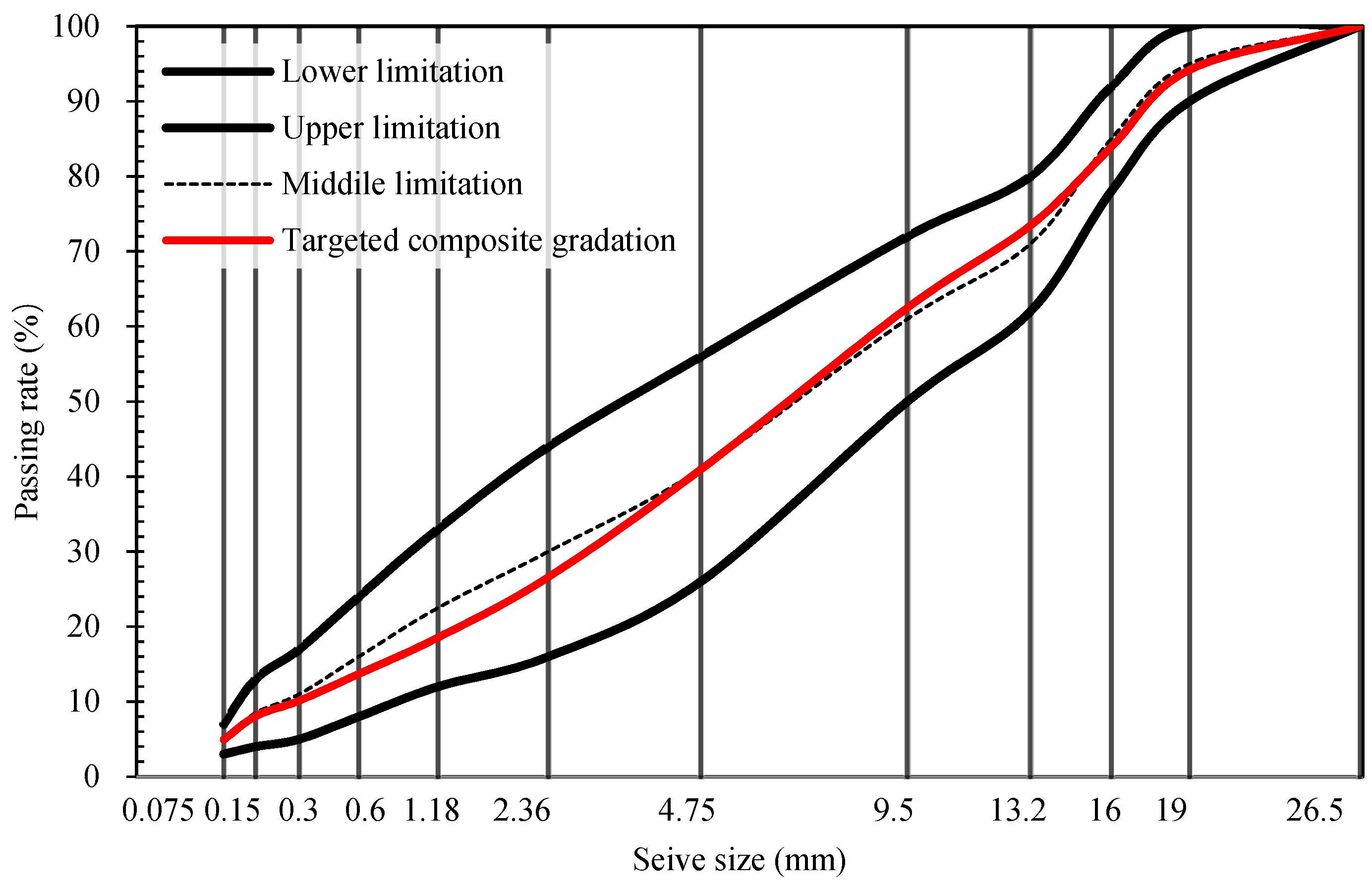
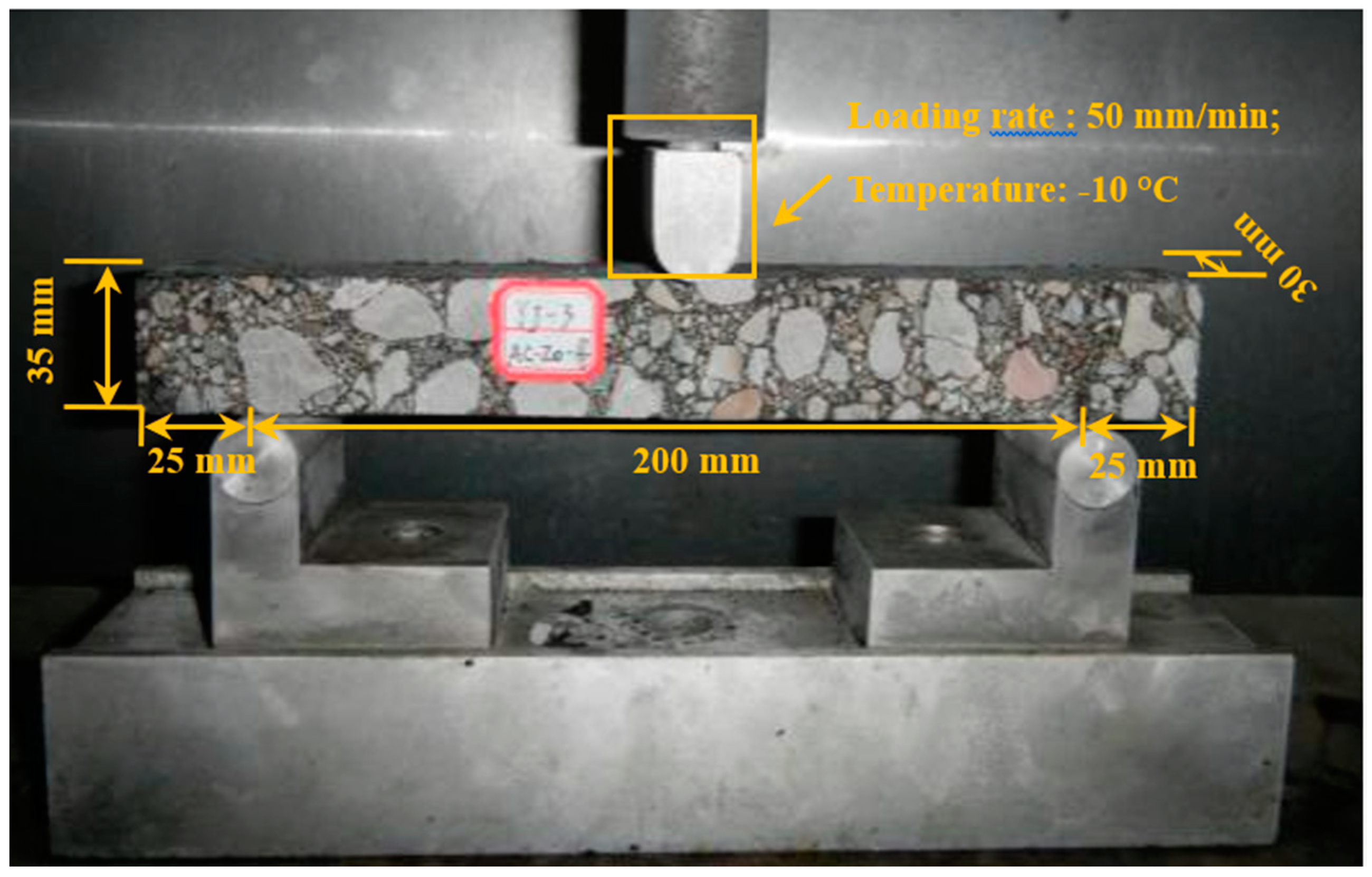
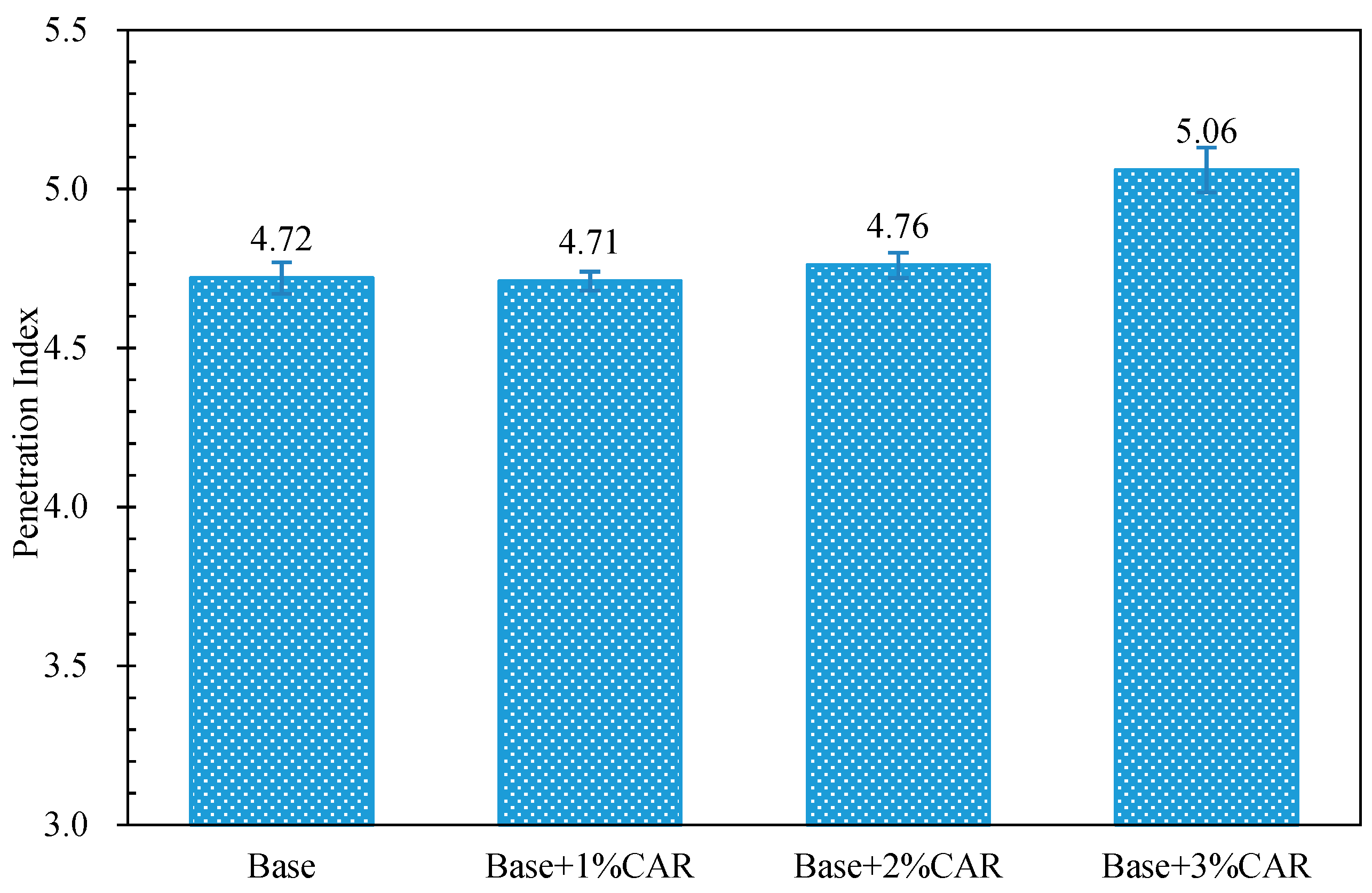

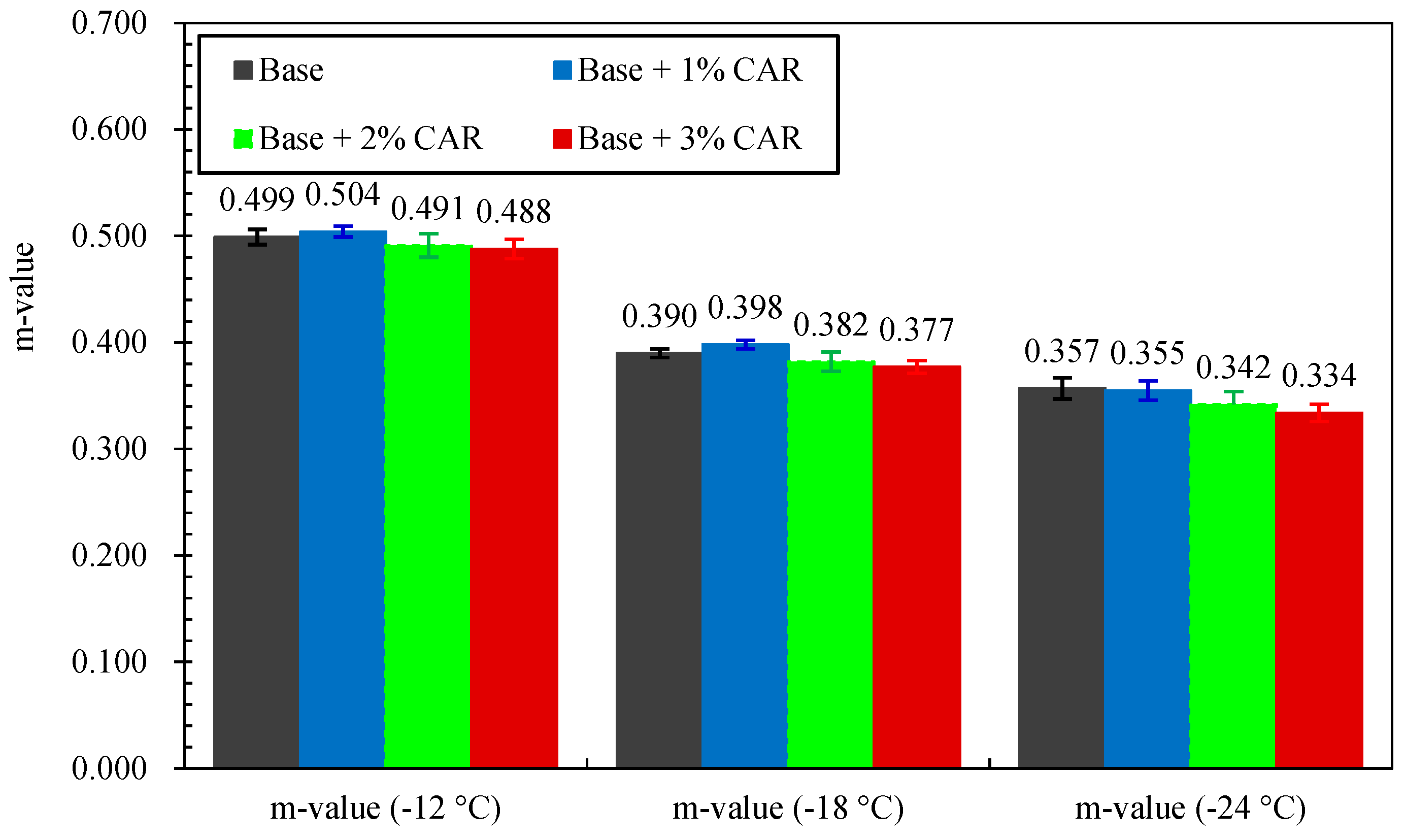
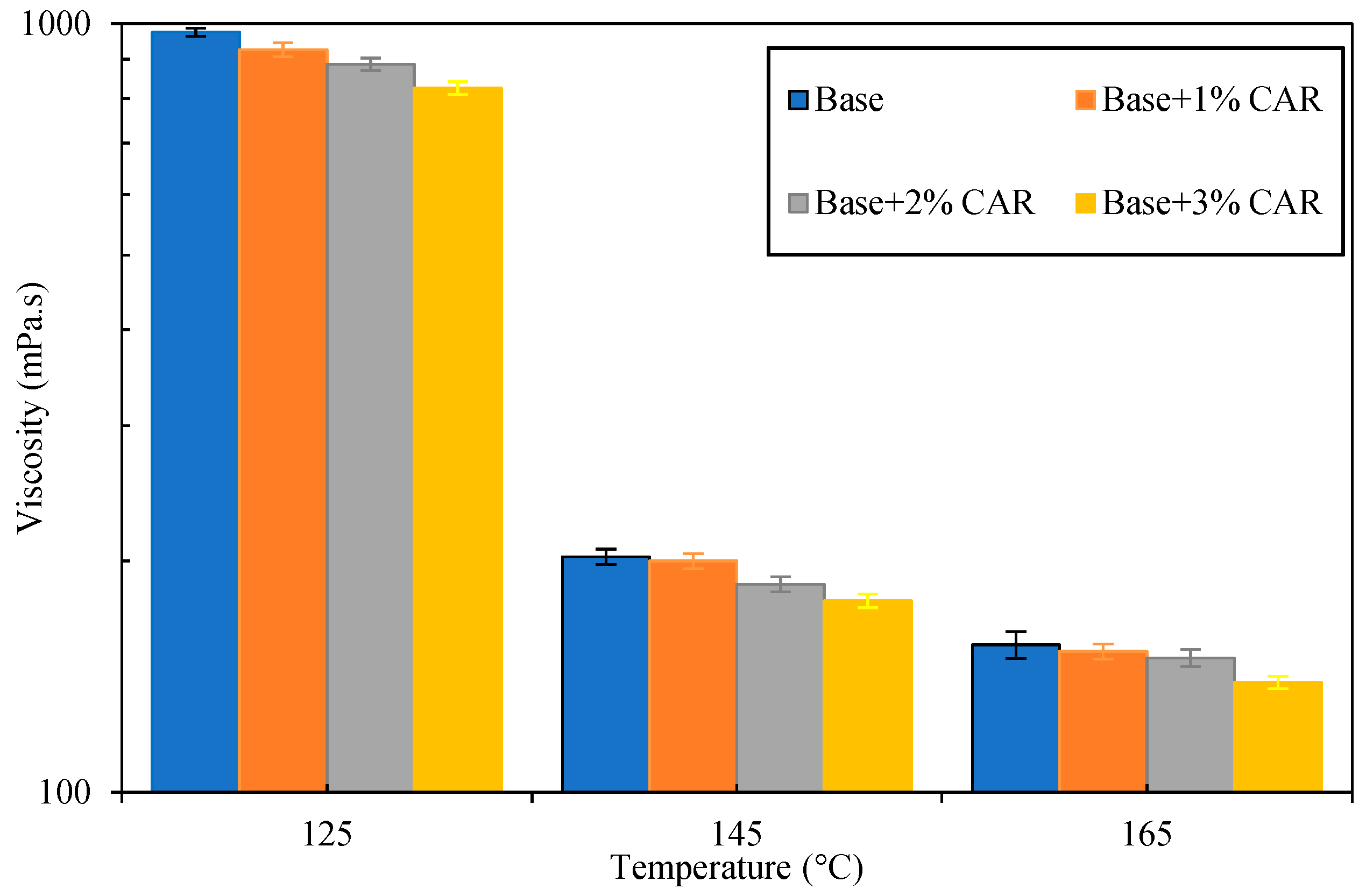
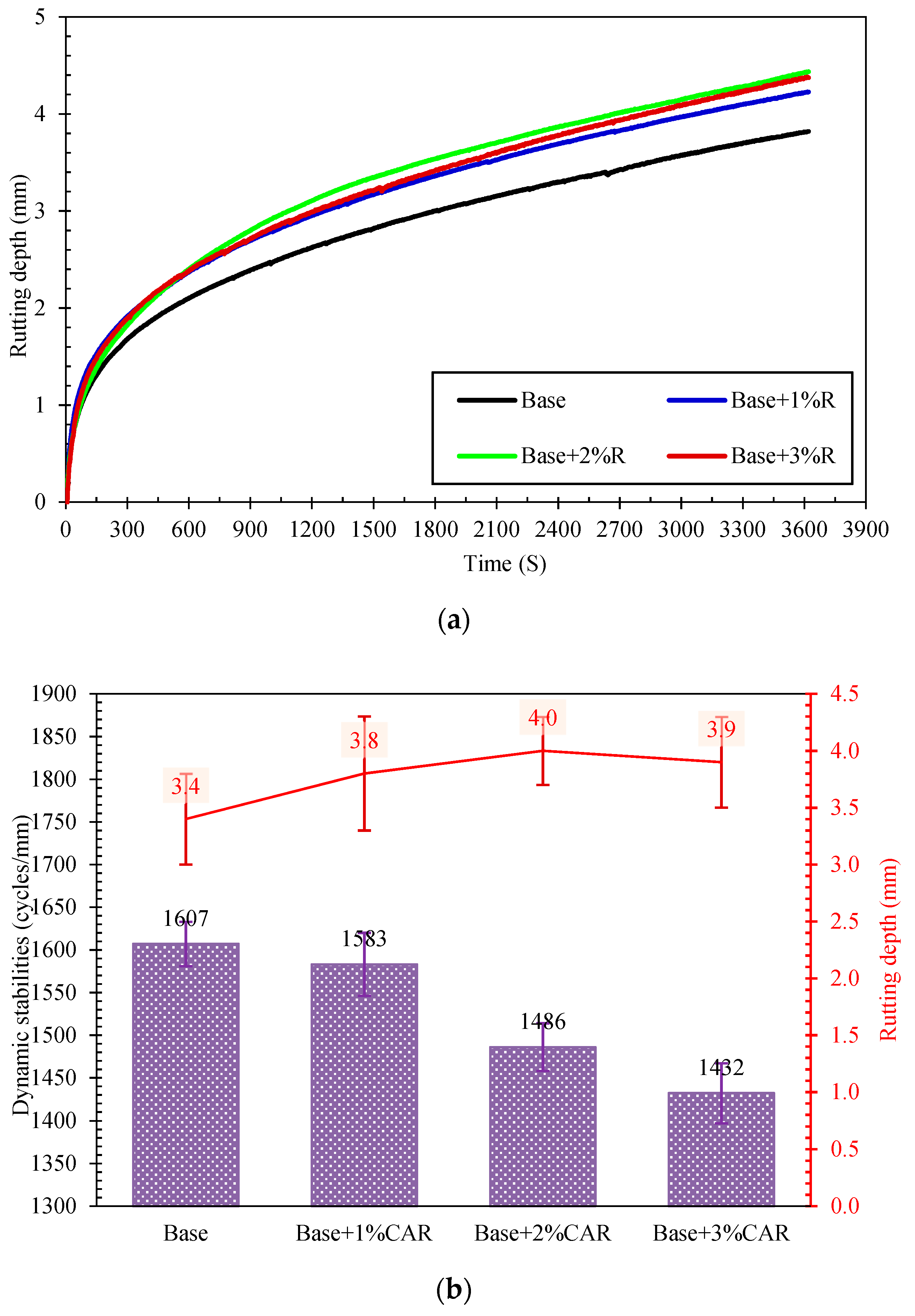
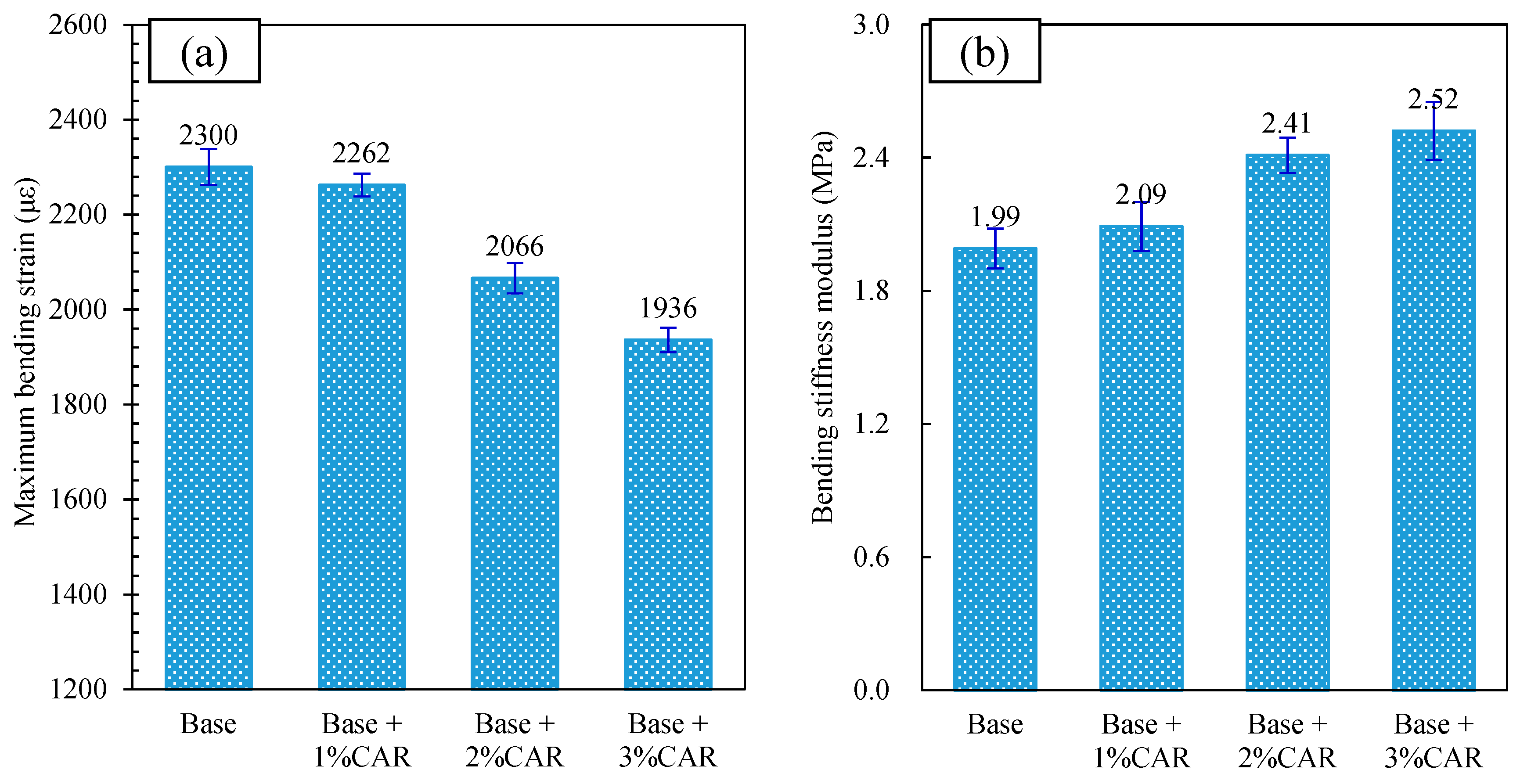
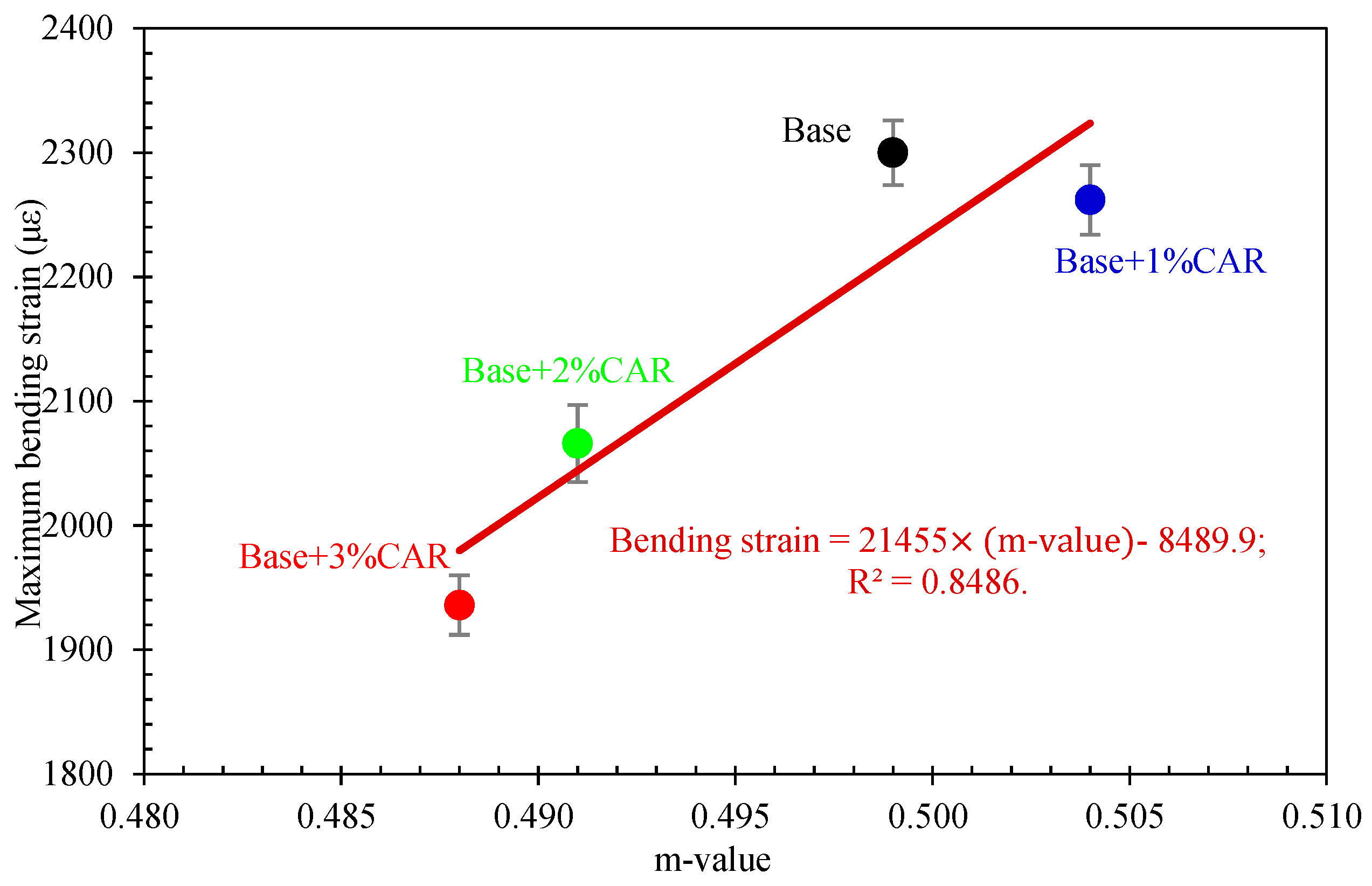
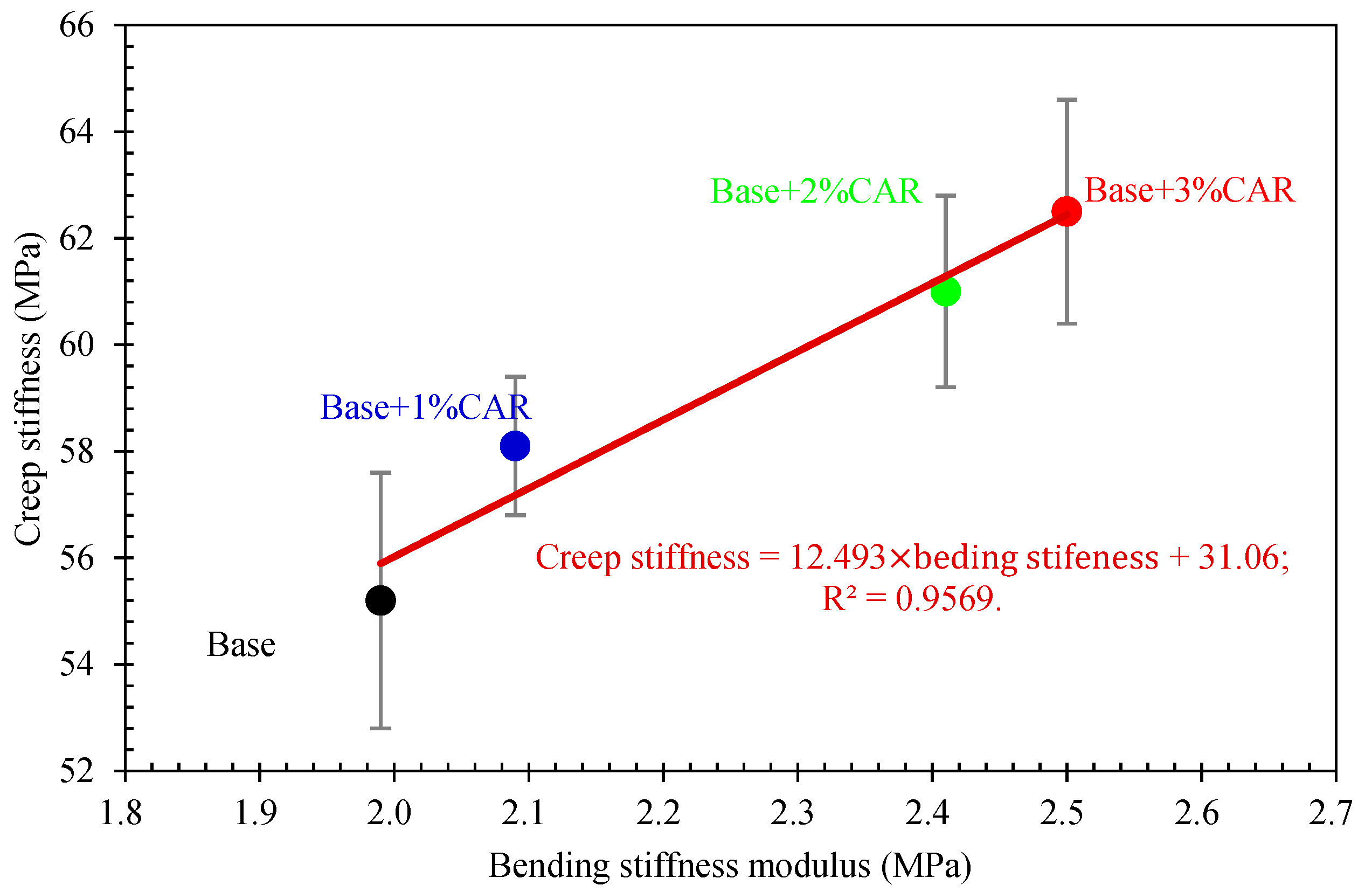
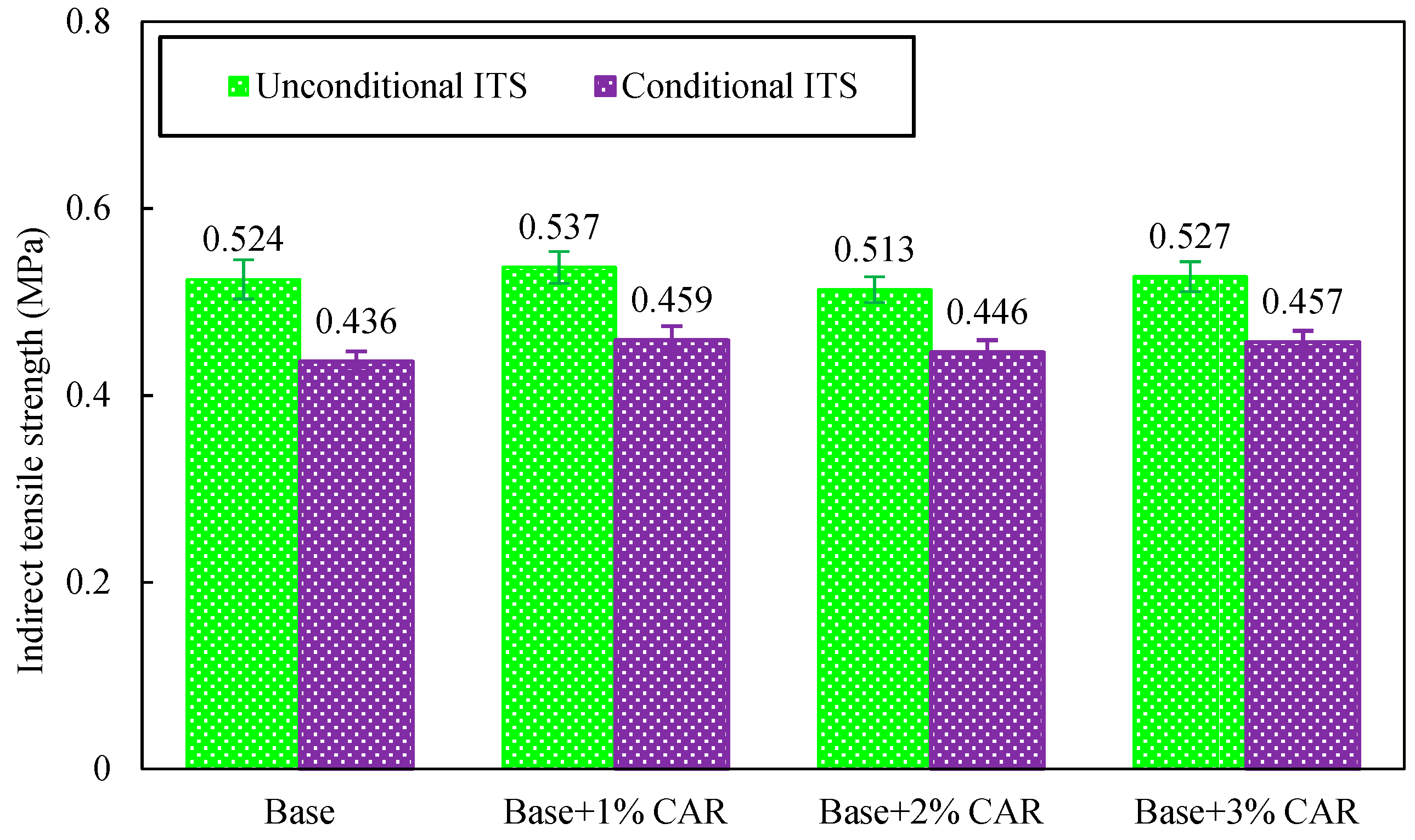
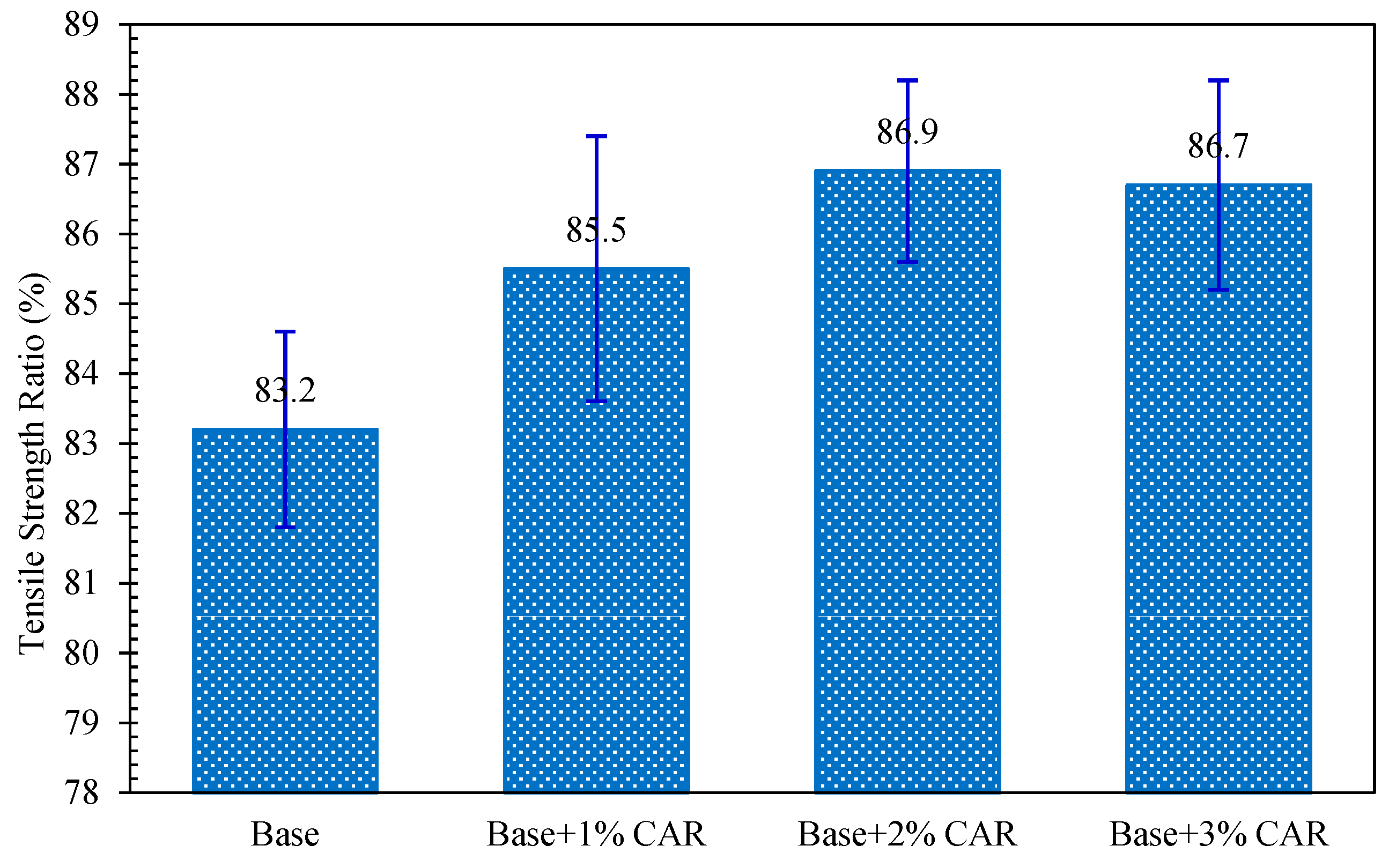
| Technical Performance | Units | Results | Criteria | Methods |
|---|---|---|---|---|
| Penetration (100 g, 25 °C, 5 s) | 0.1 mm | 68 | 60–80 | American Society for Testing and Materials (ASTM) D5 |
| Softening point | °C | 48.2 | ≥46 | ASTM D36 |
| Ductility (15 °C) | cm | 150 | ≥100 | ASTM D113 |
| Technical Information | Results | |||
|---|---|---|---|---|
| 10–20 mm | 5–10 mm | 0–5 mm | Mineral Filler | |
| Apparent specific gravity | 2.738 | 2.725 | 2.734 | 2.674 |
| Bulk specific gravity | 2.724 | 2.671 | 2.674 | - |
| Water absorption ratio (%) | 0.4 | 0.7 | 0.8 | - |
| Los Angeles abrasion loss (%) | 19.3 | - | - | - |
| Crushing value (%) | 15.4 | - | - | - |
| Sand equivalent (%) | - | - | 69 | - |
| Hydrophilic coefficient | - | - | 0.51 | |
| Performance | Parameters | Description and Results |
|---|---|---|
| Physical performance | Color | Brown |
| Bulk density (g/cc) | 0.55 | |
| Melting point (°C) | From 80 to 90 | |
| Flash point (°C) | >150 | |
| Chemical performance | Solubility in water | Water-free |
| Chemical composition | Long-chain aliphatic hydrocarbon and a group |
| Property | Base | Base + 1% CAR | Base + 2% CAR | Base + 3% CAR | ||||
|---|---|---|---|---|---|---|---|---|
| Result | SD | Result | SD | Result | SD | Result | SD | |
| Softening point (°C) | 48.2 | 0.2 | 48.4 | 0.2 | 49.8 | 0.3 | 51.5 | 0.2 |
| Penetration (0.1 mm) | 68.3 | 0.3 | 67.5 | 0.3 | 63.9 | 0.3 | 63.6 | 0.2 |
| CAMB | Base | Base + 1% CAR | Base + 2% CAR | Base + 3% CAR | ||||
|---|---|---|---|---|---|---|---|---|
| Result | SD | Result | SD | Result | SD | Result | SD | |
| Failure temperature (°C) | −21.4 | 0.2 | −21.3 | 0.2 | −20.8 | 0.1 | −20.6 | 0.2 |
© 2019 by the authors. Licensee MDPI, Basel, Switzerland. This article is an open access article distributed under the terms and conditions of the Creative Commons Attribution (CC BY) license (http://creativecommons.org/licenses/by/4.0/).
Share and Cite
Zhang, J.; Li, P.; Sun, C.; Liang, M.; Li, Y.; Yao, Z.; Zhang, X. Effects of Composite Warm Mix Additive (CAR) on the Physical and Rheological Performance of Bitumen and the Pavement Performance of Its Concrete. Materials 2019, 12, 3916. https://doi.org/10.3390/ma12233916
Zhang J, Li P, Sun C, Liang M, Li Y, Yao Z, Zhang X. Effects of Composite Warm Mix Additive (CAR) on the Physical and Rheological Performance of Bitumen and the Pavement Performance of Its Concrete. Materials. 2019; 12(23):3916. https://doi.org/10.3390/ma12233916
Chicago/Turabian StyleZhang, Jizhe, Peizhao Li, Changjun Sun, Ming Liang, Yuanyuan Li, Zhanyong Yao, and Xiaomeng Zhang. 2019. "Effects of Composite Warm Mix Additive (CAR) on the Physical and Rheological Performance of Bitumen and the Pavement Performance of Its Concrete" Materials 12, no. 23: 3916. https://doi.org/10.3390/ma12233916
APA StyleZhang, J., Li, P., Sun, C., Liang, M., Li, Y., Yao, Z., & Zhang, X. (2019). Effects of Composite Warm Mix Additive (CAR) on the Physical and Rheological Performance of Bitumen and the Pavement Performance of Its Concrete. Materials, 12(23), 3916. https://doi.org/10.3390/ma12233916







